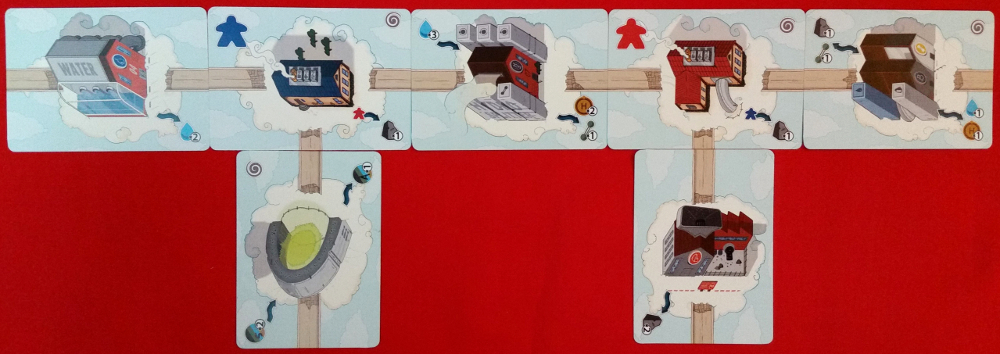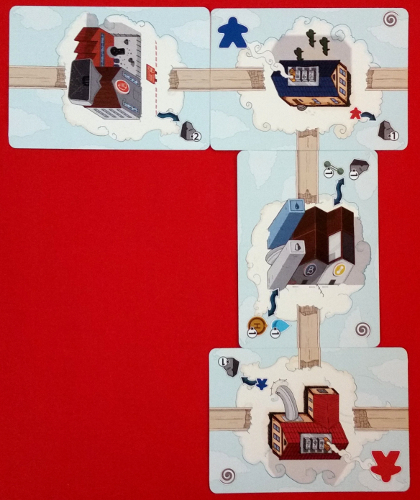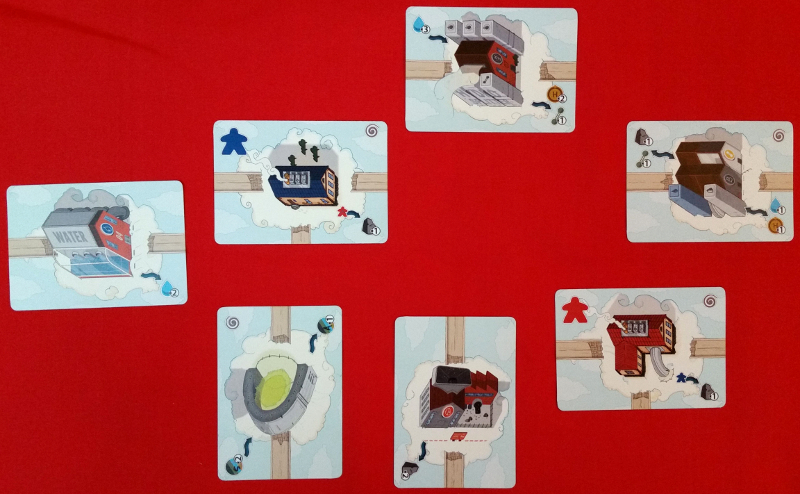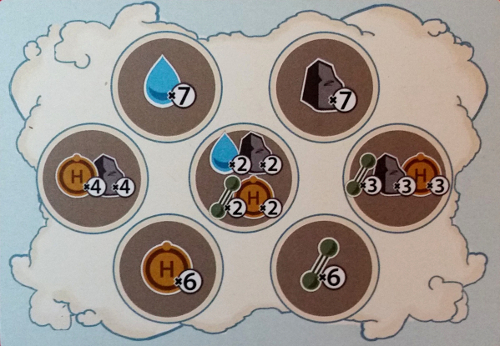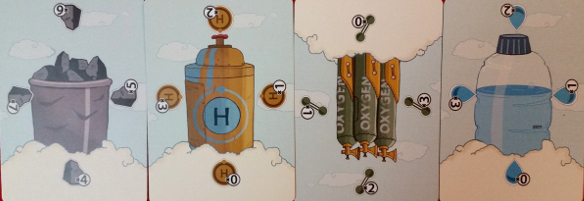The chief challenge with any Euro-styled microgame is distilling it down in a way that captures the essence of the genre its evoking while retaining the enjoyment those games bring. It can be especially difficult attempting to whittle down games of a genre that are traditionally known for being lengthy and complex affairs because their appeal is the complexity and puzzle-solving nature of those systems. What happens with many microgame adaptations, then, is in the rush to create a game with a short play time and the tiniest footprint possible, the essence of what they’re attempting to recreate is lost.
Many. But not all.
Welcome to an exception to that rule.
Ahead In The Clouds is the latest game featured in Jason Tagmire’s Button Shy microgame series. In this 20 minute two player micro-adventure created by designer Daniel Newman, you are industrialists in a world where air quality is a privilege, not a right. By extracting dust and other gases from the atmosphere high in the sky, the goal is to make breathing a little easier on everyone – while making a buck or two in the process.
What makes this particular microgame stand out so well is twofold. First, it’s a creative wallet-sized adventure that provides basic but meaningful choices even with such a very limited scope of gameplay. Secondly, the game insists that it’s a fully playable game consisting of a mere 17 cards. In fact, there are really only seven cards actively utilized throughout the course of the game, which in reality is an even bigger testament to this mini-sized homage to Euro resource games. They look something like this:
Ahead In The Clouds takes place over eight short rounds. On a player’s turn, they have three action points to spend towards any of the game’s three possible actions: Activate, Disconnect, or Cloudburst.
Of the seven primary cards in the game, five are buildings that can be activated to either gather one of the game’s four main resources (stone, water, oxygen, and hydrogen) or convert resources of one type into another. The other two are the bases (habitats) of each player. To activate a location, you must be able to trace a path from your habitat to that building.
The only caveat is that if you go through your opponent’s habitat to reach it, they get a free resource. So if you’re off floating around on one cloud and the bank is on another, or you simply don’t want to give your inferior cloud farming opposition free stuff, then you’ll have to forge another path. This is done by reshaping the board.
Like the clouds themselves, the layout of the cards in this game is constantly fluctuating. Much of the game’s mild strategy resides in manipulating and changing the board enough so that you can achieve your goals while making it ever-so-slightly more difficult for the other player to do the same – usually by making them spend precious actions to achieve theirs. Because resource control is so tight in this tiny setting, any means to avoid giving free resources to your opponent is one that should be taken.
The best way to do this is by forming new paths to the locations you want, free of your meddling competition. That’s where the latter actions come in. Both Disconnecting and Cloudbursts are means by which you can break apart the current not-so-rainbow bridge linking cloud roads together. Disconnecting allows you to separate any building or buildings attached to your habitat. Similarly, performing a Cloudburst breaks apart all cards. The bonus to this effect, though, is that four of the seven cards are double-sided, and this action allows you to flip one to the other side for their alternative reward/action.
This process of shifting the board around and striving to be the most efficient at getting the resources to complete contracts lies at the heart of this game. Ahead In The Clouds is effectively a race to convert one resource into another in the right combinations, all set aloft in the skies of a highly configurable board state.
The ideal approach is, naturally, to attach your habitat to the buildings you need most, which is done on your turn as a free action. Likewise, you can claim any available contracts on your turn by turning in the necessary number of resources. Be the person with the most contacts after eight rounds, and you’ll be raking in the…erm…precious dust vapor?
Ahead In The Clouds won’t replace your love or desire to play your favorite resource management games; those who come into it thinking it will provide the same degree of strategic depth or weighty decisions as the games it alludes to will find themselves sorely disappointed. However, the game wisely doesn’t claim to offer that. Instead, it provides the opportunity to play a highly truncated version in less time it takes setting some of those games up. And it does so particularly well.
Ahead In The Clouds may take place up in the sky, but its approach is quite grounded. By maximizing the resource gathering experience with as few components and shortest time possible, it succeeds in an area where many other microgames fail: evoking the feeling of a heavier game without being overly reductionist. Indeed, this is one microgame that actually accomplishes that goal, fleeting as that feeling may be.
Thanks to quick gameplay, and a clever card arrangement premise, it does a commendable job helping you scratch that Euro-centric itch in those moments when you don’t have the time or capability to play something meatier. Through just 17 cards and a 20 minute time frame, it provides the basic pressures of desperately needing just one more turn to get the materials you need and the rewarding sensation of outmaneuvering your opponent to claim the same objective that you both were going after. Much like the clouds it takes place upon, this is a decent example of a microgame that is easily greater than the sum of its parts.
If you’d like to learn more about the exciting world of dust reclamation and vapor condensing (no, really), Ahead In The Clouds is doing a 20 minute crash course right now over on its Kickstarter.
Operators are standing by.
Photo Credits: Ahead In The Clouds cover and artwork by Button Shy Games.

